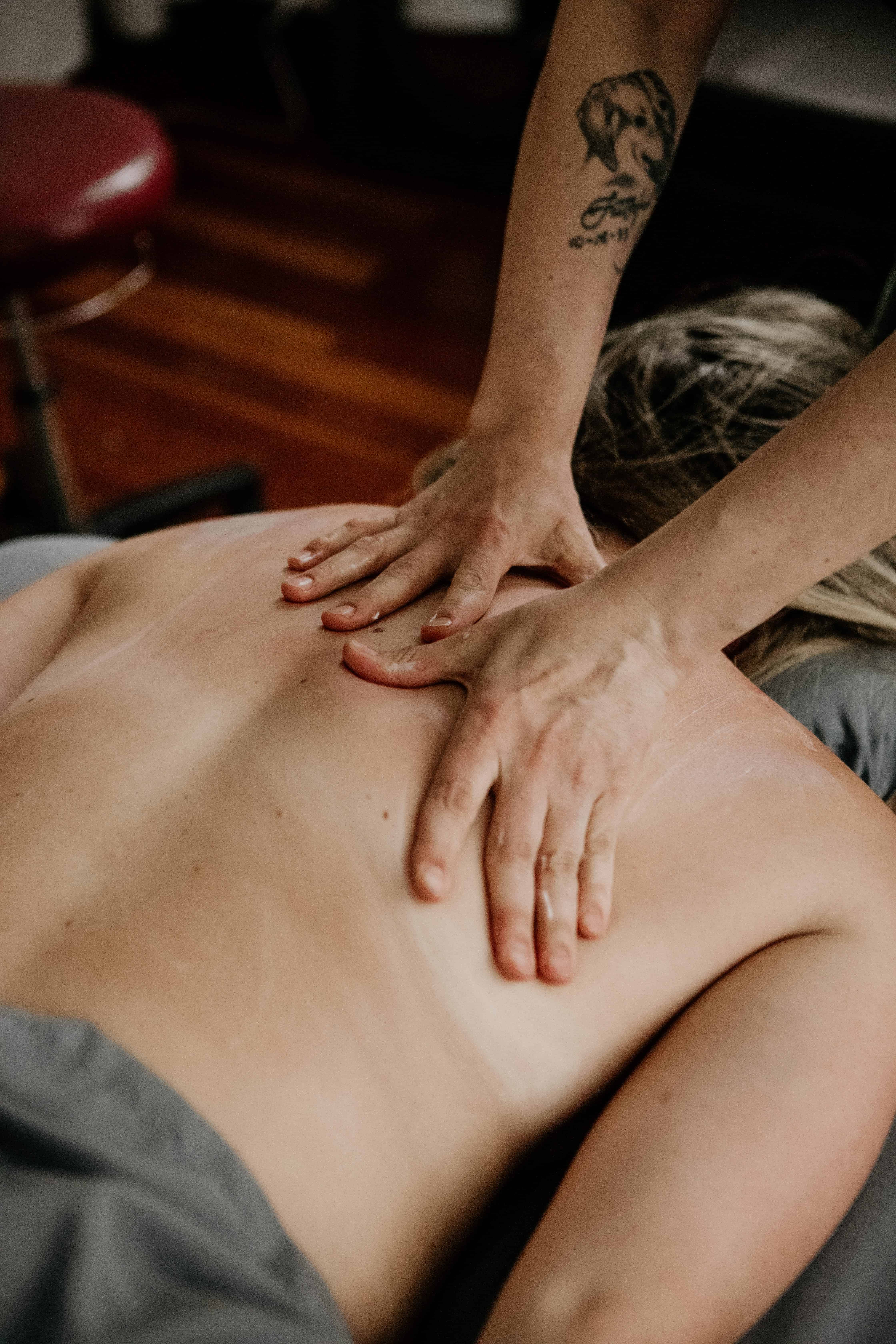The biggest differences between deep tissue massage and Swedish massage are the techniques used and the end goal of the massage.
Swedish massage focuses more on relaxation, while deep tissue massage involves working through chronic pain or finding relief from injuries.
Massage is a self-care essential that goes beyond just feeling relaxed (although that’s pretty darn amazing, too!). So in this post, we’ll get deep (pun intended) into the details of Swedish massage and deep tissue massage, two popular techniques that can leave you feeling ahh-mazing, but involve different techniques and goals.
As your massage therapist (and fellow human navigating this crazy world!), I want to empower you to choose the exact experience your body and soul are craving at this point in your healing journey.

Swedish Massage: The Ultimate Relaxation Ritual
Swedish massage helps your body melt away (physical and emotional!). It focuses on using light to firm pressure to improve circulation, ease muscle tension, and leave you utterly blissed.
It’s like a giant hug for your whole body. Perfect for when you need to de-stress, unwind, and reconnect with your true self.
What are the Benefits of Swedish Massage?
- Reduced Stress and Anxiety: The rhythmic strokes and focus on relaxation can significantly lower stress hormones like cortisol, leaving you feeling calmer and more centered.
- Improved Sleep: A Swedish massage can ease tension headaches and promote relaxation, making it easier to drift off to sleep and enjoy a deeper, more restful night.
- Enhanced Circulation: The massage strokes help to increase blood flow throughout the body. Increased blood flow delivers oxygen and nutrients throughout your muscles and tissues, promoting healing and reducing aches and pains.
- Improve Flexibility and Your Range of Motion: Swedish massage therapy loosens tight muscles and improves flexibility, making it easier to move your body and potentially reducing the risk of future injuries.
- Pain Relief: While not as targeted as deep tissue massage, a Swedish massage can still be very effective in relieving general aches and pains, especially those caused by stress and tension.
- Improved Mood: The relaxation response triggered by a Swedish massage can leave you feeling happier and more positive.
Who is Swedish Massage For?
Swedish massage is a fantastic option for a wide range of people, including:
- Those seeking relaxation and stress relief: This is a perfect choice if you’re feeling overwhelmed, burnt out, or just need a little “me time” to unwind.
- People new to massage: The gentle pressure and calming atmosphere make Swedish massage a great introduction to massage therapy.
- Pregnant women (with doctor’s approval): Swedish massage is save and effective for common pregnancy discomforts like backaches, leg cramps, and fatigue. However, it’s important to communicate openly with your massage therapist and doctor to ensure the massage is tailored to your specific needs.
- People with chronic pain conditions: While Swedish massage may not be a cure-all for chronic pain, it helps to manage symptoms.
How Does Deep Tissue Massage Differ From Swedish Massage?
Deep tissue massage is like the personal trainer of the massage world. It uses firmer pressure and more targeted techniques. This can be amazing for chronic pain, injury recovery, and loosening up tight knots.
Deep Tissue Massage Techniques:
Techniques to reach those deeper muscle layers, include:
- Friction: The therapist applies direct pressure using thumbs, elbows, or forearms to break down adhesions and tight muscle knots.
- Stripping: Long strokes are applied with the hands or forearms across the grain of the muscle to lengthen and loosen muscle fibers.
- Trigger point therapy: The therapist focuses on specific, tender spots in the muscles (called trigger points) that can cause pain in other areas of the body.
Deep Tissue Massage Benefits
- Pain Relief: Deep tissue massage is a powerful option for improving chronic pain related to fibromyalgia, low back pain, and headaches. Targeting specific areas of tension and releasing trigger points can significantly reduce pain and improve mobility.
- Improved Posture: Tight muscles can pull your body out of alignment, leading to poor posture. Deep tissue massage helps loosen tight muscles and improve your posture, reducing pain and discomfort.
- Injury Recovery: Deep tissue massage promotes healing after an injury by increasing blood flow to the area, reducing inflammation, and speeding up the healing process.
- Increased Range of Motion: Deep tissue massage loosens tight muscles and connective tissue, to make daily activities and movements easier and more comfortable.
Who is Deep Tissue Massage For?
Deep tissue massage isn’t for everyone. While it can be incredibly beneficial, the targeted and intense nature of the work may not be suitable for all. Here’s a breakdown of who can benefit most from deep tissue massage:
- Athletes and Active Individuals: Deep tissue massage can help athletes recover from workouts and injuries faster by reducing muscle soreness, improving flexibility, and increasing range of motion.
- People with Chronic Pain: As mentioned earlier, deep tissue massage is a powerful tool for managing chronic pain conditions. It can be especially helpful if pain is caused by tight muscles, trigger points, or repetitive strain injuries.
- Those with Poor Posture: Deep tissue massage can help to improve posture by addressing muscle imbalances and tightness that contribute to poor alignment.
- Those Seeking Improved Flexibility: Deep tissue massage can help to loosen tight muscles and connective tissue, making it easier to move your body and achieve a greater range of motion.
What to Consider Before Choosing a Deep Tissue Massage:
- Pain Tolerance: Deep tissue massage can be uncomfortable, especially if you have a lot of muscle tension, but it should not hurt. Don’t be shy. Communicate openly before and during your massage so your therapist understands your pain tolerance and desired pressure level.
- Medical Conditions: Certain medical conditions may make deep tissue massage inadvisable. If you have any concerns, such as blood clots, osteoporosis, or recent surgery, consult with your doctor before getting a deep tissue massage.
- Sensitivity: Deep tissue massage can cause temporary soreness or bruising, especially after the first session. Let your therapist know if you have any specific areas of sensitivity.
Additional Tips to Get the Most from Your Massage
- Hydration is Key: Drink water (ideally with electrolytes) before and after your massage to help flush out toxins released during the treatment.
- Communicate: Don’t be afraid to speak up and let your massage therapist know if the pressure is too much or if there are any areas you’d like them to focus on.
- Listen to Your Body: After your massage, it’s important to listen to your body. You may experience some temporary soreness or stiffness, which is normal. However, if you experience any pain that doesn’t subside within a few days, be sure to contact your massage therapist or doctor.
What Type of Massage is Right for You?
The best way to decide which type of massage is right for you is to consider your individual needs and preferences. When you book your massage with me at Visionairium, we’ll chat about your goals, any areas of concern, and your comfort level with pressure.
Together, we can create a massage experience that leaves you feeling rejuvenated, relaxed, and ready to take on the world!
Ready to give your body the love it deserves? Book your massage with me, Leah, at Visionairium today, and let’s create a self-care experience that leaves you feeling empowered, radiant, and oh-so-relaxed. You deserve it!
